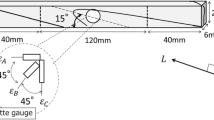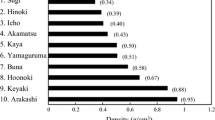Abstract
It has been repeatedly observed that the mechanical properties of microtomed wood sections are significantly lower than those of samples of normal size, but few investigations have been conducted to deal with this topic, especially based on theoretical approaches. We measured the longitudinal MOE of Chinese fir on microtomed sections ranging in thickness from 70 to 200 µm and compared these with the values of samples of normal size. The results indicate that the MOE of microtomed wood sections increases with thickness from 70 to 200 µm, but is significantly less than that of normal samples. A size effect coefficient of 2.63 is inferred based on statistical data for samples of normal size and 200 µm thick microtomed sections. Finally, an explanation based on a complete shear restraint model of cell walls and a single fiber multi-ply model is proposed for the size effect on stiffness of microtomed wood sections.
Similar content being viewed by others
References
Barber N F, Meylan B A. 1964. The anisotropic shrinkage of wood: a theoretical model. Holzforschung, 18(5): 146–156
Barber N F. 1968. A theoretical model of shrinking wood. Holzforschung, 22(4): 97–103
Biblis E J. 1969. Tension properties of loblolly pine growth zones. Wood Fiber, 1(1): 18–28
Biblis E J. 1970. Effect of thickness of microtensile sections on their tensile properties. Wood Fiber, 2(1): 19–31
Boding J. 1982. Mechanics of Wood and Wood Composite. New York: Van Norstrand Reinhold Company Inc, 156–157
Burgert I, Jungnikl K. 2004. Adaptive growth of gymnosperm branches-ultrastructural and micromechanical examinations. J Plant Growth Regul, 23(2): 76–82
Keckes J, Burgert I, Frühmann K, Müller M, Kölln K, Hamilton M, Burghammer M, Roth S V, Stanzl-Tschegg S, Fratzl P. 2003. Cell-wall recovery after irreversible deformation of wood. Nat Mater, 2: 810–814
Mark R E, Gills P P. 1970. New models in cell-wall mechanics. Wood Fiber Sci, 2(2): 79–95
Mark R E.1967. Cell Wall Mechanics of Trachieds. New Haven: Yale University Press
Navi P, Rastogi P K, Gresse V, Tolou A. 1995. Micromechanics of wood subjected to axial tension. Wood Sci Technol, 29(6): 411–429
Reiterer A, Lichtenegger H, Fratzl P, Stanzl-Tschegg S E. 2001. Deformation and energy absoption of wood cell walls with different nanostructure under tensile loading. J Mater Sci, 36(19): 4681–4686
Reiterer A, Lichtenegger H, Tschegg S, Fratzl P. 1999. Experimental evidence for a mechanical function of the cellulose microfibril angle in wood cell walls. Phil Mag A, 79(9): 2173–2184
Salmén L, Burgert I. Cell wall features with regard to mechanical performance. A review. Holzforschung, 2009, 63(2): 121–129
Schniewind A P, Barrett J D. 1969. Cell wall model with complete shear restraint. Wood Fiber Sci, 1(3): 205–214
Schniewind A P. 1959. Transverse anisotropy of wood. Forest Prod J, 9(10): 350–359
Sippola M, Frühmann K. 2002. In situ longitudinal tensile tests of pine wood in an environmental scanning electron microscope. Holzforschung, 56(6): 669–675
Thuvander F L, Wallstrom L, Berglund L A, Lindberg K A H. 2001. Effect of an impregnation procedure for prevention of wood cell wall damage due to drying. Wood Sci Technol, 34(6): 473–480
Turkulin H, Sell J. 2002. Investigation into the photodegradation of wood using microtensile testing. Holz als Roh-und Werkstoff, 60(2): 96–105
Yu Y. 2003. The longitudinal mechanical properties and its main factors of tracheids of Chinese fir from plantation. Ph.D Thesis. Beijing: Chinese Academy of Forestry
Author information
Authors and Affiliations
Corresponding author
Rights and permissions
About this article
Cite this article
Yu, Y., Jiang, Zh. & Tian, Gl. Size effect on longitudinal MOE of microtomed wood sections and relevant theoretical explanation. For. Stud. China 11, 243–248 (2009). https://doi.org/10.1007/s11632-009-0040-3
Received:
Accepted:
Published:
Issue Date:
DOI: https://doi.org/10.1007/s11632-009-0040-3




